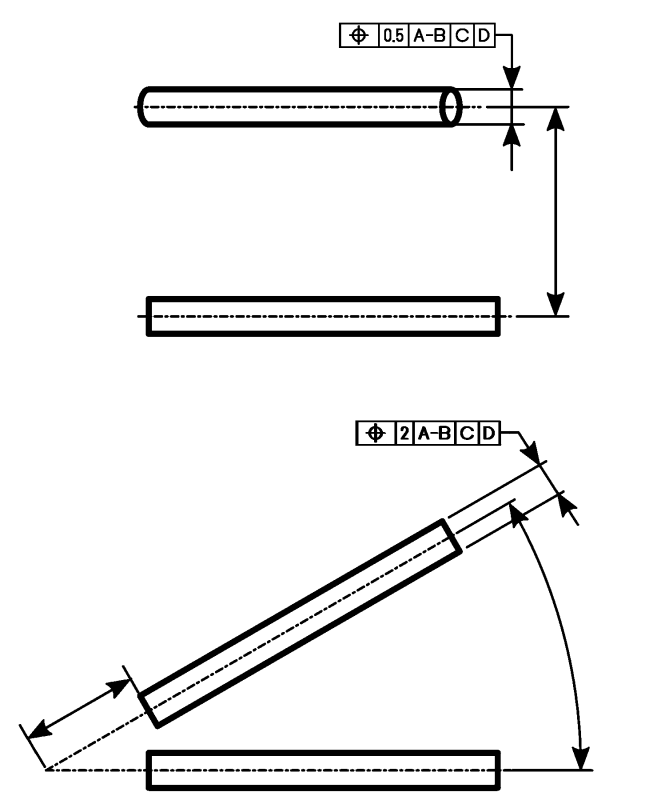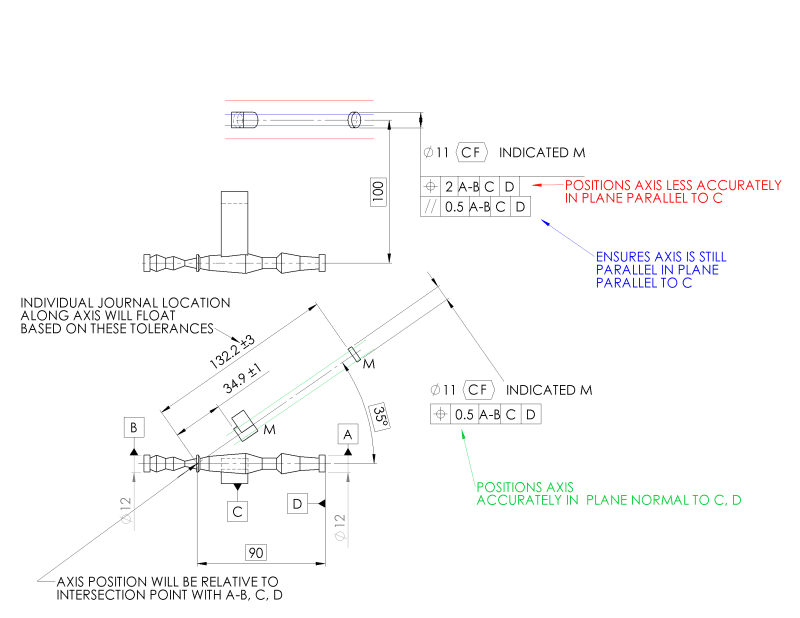This seems like an extremely elementary question but I haven't been able to find anything explicit on it.
I always thought it didn't matter which view you place your FCF or basic dimensions on (other than for clarity), but I'm coming across a specific problem with that thought (axis parallel to another axis in one view, angled to it in another. Both need tolerancing)
For example, if you put an angularity FCF on an axis, with the basic dimension between itself and a plane, and reference that plane as the datum, are you creating a conical tolerance zone or a planar one? If it is planar, who defines the plane that it is orthogonal to, other than the direction of the drawing view itself? You could include that plane in the FCF, but there is no way to say you mean that the basic dimension is measured on a plane normal to that plane, since basic dimensions themselves don't have reference frames.
Figure 6-6 and 6-7 in Y14.5-2009 appear to implicitly address this.
6-6 shows a diametrical tolerance zone created by an angularity FCF with only one datum plane. The implication is that the tolerance zone runs parallel to the plane of the drawing view (perpendicular to the viewing direction).
6-7 shows that by excluding the diameter symbol, you create two planes to define the tolerance zone, which again are projected along the viewing direction.
Ultimately I have an issue where I can use this quirk to solve my issue where I need parallelism of an axis to an axis in one view and angularity to that same axis in another (whereas if view doesn't matter, you can't have both parallelism and angularity of the same two axes to eachother, and then I don't know what to do), but using GD&T in this way (assuming that the view matters) does add a lot of other questions:
1) Am I about to create a whole bunch of confusion? Or is this something everyone else already knows about, and I'm just late to the party?
2) Who defines the reference frame for the view and the tolerance on that?
3) Is the implication here that FCFs in general only apply to basic dimensions that are in the same view that they are placed on?
4) Does the view matter with other controls? For example, position? If I want strong control of true position on 2 axes and weak control on another, can I apply an FCF with a tight tolerance in a view with those basic dimensions, and the FCF with the weak tolerance on a view with that basic dimension?
Thanks very much.
I always thought it didn't matter which view you place your FCF or basic dimensions on (other than for clarity), but I'm coming across a specific problem with that thought (axis parallel to another axis in one view, angled to it in another. Both need tolerancing)
For example, if you put an angularity FCF on an axis, with the basic dimension between itself and a plane, and reference that plane as the datum, are you creating a conical tolerance zone or a planar one? If it is planar, who defines the plane that it is orthogonal to, other than the direction of the drawing view itself? You could include that plane in the FCF, but there is no way to say you mean that the basic dimension is measured on a plane normal to that plane, since basic dimensions themselves don't have reference frames.
Figure 6-6 and 6-7 in Y14.5-2009 appear to implicitly address this.
6-6 shows a diametrical tolerance zone created by an angularity FCF with only one datum plane. The implication is that the tolerance zone runs parallel to the plane of the drawing view (perpendicular to the viewing direction).
6-7 shows that by excluding the diameter symbol, you create two planes to define the tolerance zone, which again are projected along the viewing direction.
Ultimately I have an issue where I can use this quirk to solve my issue where I need parallelism of an axis to an axis in one view and angularity to that same axis in another (whereas if view doesn't matter, you can't have both parallelism and angularity of the same two axes to eachother, and then I don't know what to do), but using GD&T in this way (assuming that the view matters) does add a lot of other questions:
1) Am I about to create a whole bunch of confusion? Or is this something everyone else already knows about, and I'm just late to the party?
2) Who defines the reference frame for the view and the tolerance on that?
3) Is the implication here that FCFs in general only apply to basic dimensions that are in the same view that they are placed on?
4) Does the view matter with other controls? For example, position? If I want strong control of true position on 2 axes and weak control on another, can I apply an FCF with a tight tolerance in a view with those basic dimensions, and the FCF with the weak tolerance on a view with that basic dimension?
Thanks very much.



